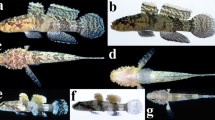Abstract
Oithona davisae Ferrari and Orsi were collected from the innermost region of Tokyo Bay, Japan, in 1980 and 1981. The mating behavior of this marine cyclopoid copepod consists of several steps, starting with the paddling of the male in random search of a mate. This behavior is followed by a spiraling movement in pursuance of a mate. Next is the copulatory grasp during which the male grasps the fourth swimming legs of the female partner by means of his first antennae. Whilst in this position, the male's urosome vibrates to allow the spermatophores to extrude from his genital openings. The mating behavior then culminates in the spermatophore transfer. Males do not grasp the uro-some or caudal setae of the mating partner before proper copulatory grasp. The specialized setae of the female's fourth legs may help the male to grasp her legs firmly. Spiraling occurs when the male approaches or traverses the trail of a female that is ready to copulate and that presumably emits a sex-attractant pheromone. The turning radius reduces gradually from more than 1 mm to ca. 0.25 mm as the male approaches the mate female. Females may register spiraling as a mate (male)-approaching signal. Spiraling may lead the male to locate a pheromone source more accurately, and to promote diffusion of the pheromone to prevent other males from pursuing the source. This swimming strategy can increase the copulatory chance of mature virgin females.
Similar content being viewed by others
Literature cited
Atema, J., Engstrom, D. G. (1971). Sex pheromone in the lobster,Homarus americanus. Nature, Lond. 232: 261–263
Blades, P. I. (1977). Mating behavior ofCentropages typicus (Copepoda: Calanoida). Mar. Biol. 40: 57–64
Blades, P. I., Youngbluth, M. J. (1979). Mating behavior ofLabidocera aestiva (Copepoda: Calanoida). Mar. Biol. 51: 339–355
Blades, P. I., Youngbluth, M. J. (1980). Morphological, physiological, and behavioral aspects of mating in calanoid copepods. In: Kerfoot, W. C. (ed.) Evolution and ecology of zooplankton communities. The University Press of New England, Hanover, New Hampshire, p. 39–51
Ferrari, F. D., Bowman, T. E. (1980). Pelagic copepods of the family Oithonidae (Cyclopoida) from the east coasts of Central and South America. Smithson. Contrib. Zool. No. 312: 1–27
Fraser, J. H. (1936). The occurrence, ecology and life history ofTigriopus fulvus (Fischer). J. mar. biol. Ass. U.K. 20: 523–536
Gauld, D. T. (1957). Copulation in calanoid copepods. Nature, Lond. 180: 510
Gerritsen, J. (1980). Adaptive responses to encounter problems. In: Kerfoot, W. C. (ed.) Evolution and ecology of zooplankton communities. The University Press of New England, Hanover, New Hampshire, p. 52–62
Griffiths, A. M., Frost, B. W. (1976). Chemical communication in the marine planktonic copepodsCalanus pacificus andPseudocalanus sp. Crustaceana 30: 1–8
Haq, S. M. (1972). Breeding ofEuterpina actifrons, a harpacticid copepod, with special reference to dimorphic males. Mar. Biol. 15: 221–235
Hill, L. L., Coker, R. E. (1930). Observations on mating habits ofCyclops. J. Elisha Mitchell sci. Soc. 45: 206–220
Itô, T. (1970). The biology of a harpacticoid copepod,Tigriopus japonicus Mori. J. Fac. Sci. Hokkaido Univ. Ser. VI, Zool. 17: 474–500
Itô, T. (1971). The biology of a harpacticoid copepod,Harpacticus uniremis Kröyer. J. Fac. Sci. Hokkaido Univ. Ser. VI, Zool. 18: 235–255
Jacobs, J. (1961). Laboratory cultivation of the marine copepodPseudodiaptomus coronatus Williams. Limnol. Oceanogr. 6: 443–446
Jacoby, C. A., Youngbluth, M. J. (1983). Mating behavior in three species ofPseudodiaptomus (Copepoda: Calanoida). Mar. Biol. 76: 77–86
Johnson, M. W. (1948). The postembryonic development of the copepodPseudodiaptomus euryhalinus Johnson, and its phylogenetic significance. Trans. Am. microsc. Soc. 67: 319–330
Katona, S. K. (1973). Evidence for sex pheromones in planktonic copepods. Limnol. Oceanogr. 18: 574–583
Katona, S. K. (1975). Copulation in the copepodEurytemora affinis. Crustaceana 28: 89–95
Kittredge, J. S., Takahashi, F. T., Lindsey, J., Lasker, R. (1974). Chemical signals in the sea: marine allelochemics and evolution. Fish. Bull. U.S. 72: 1–11
Kittredge, J. S., Terry, M., Takahashi, F. T. (1971). Sex pheromone activity of the molting hormone, crustecdysone, on male crabs. Fish. Bull. U.S. 69: 337–343
Marshall, S. M., Nicholls, A. G., Orr, A. P. (1934). On the biology ofCalanus finmarchicus. V. Seasonal distribution, size, weight and chemical composition in Loch Striven in 1933, and their relation to the phytoplankton. J. mar. biol. Ass. U.K. 19: 793–828
Nishida, S. (1986). Structure and function of the cephalosome-flap organ in the family Oithonidae (Copepoda, Cyclopoida). Syllogeus, Proc. Second int. Conf. Copepoda No. 58, 385–391
Parker, G. H. (1902). The reactions of copepods to various stimuli and the bearing of this on daily depth-migrations. Bull. U.S. Fish. Comm. 21: 103–123
Roff, J. C. (1972). Aspects of the reproductive biology of the planktonic copepodLimnocalanus macrurus Sars, 1863. Crustaceana 22: 155–160
Ryan, E. P. (1966). Pheromone: Evidence in a decapod crustacean. Science, Wash. D.C. 151: 340–341
Sawchyn, W. W., Hammer, U. T. (1968). Growth and reproduction of someDiaptomus spp. in Saskatchewan ponds. Can. J. Zool. 46: 511–520
Strickler, J. R., Bal, A. K. (1973). Setae of the first antennae of the copepodCyclops scutifer (Sars): Their structure and importance. Proc. ntl. Acad. Sci. U.S.A. 70: 2656–2659
Takano, H. (1971). Breeding experiments of a marine littoral copepodTigriopus japonicus Mori. Bull. Tokai Reg. Fish. Res. Lab. 64: 71–80
Uchima, M. (1979). Morphological observation of developmental stages inOithona brevicornis (Copepoda, Cyclopoida). Bull. Plankton Soc. Japan 26: 59–76
Uchima, M. (1985a). Copulation in the marine copepodOithona davisae Ferrari & Orsi. I. Mate discrimination. Bull. Plankton Soc. Japan 32: 23–30
Uchima, M. (1985b). Copulation in the marine copepodOithona davisae Ferrari & Orsi. II. Relationship between copulation and egg-laying. Bull. Plankton Soc. Japan 32: 31–36
Uchima, M., Hirano, R. (1988). Swimming behavior of the marine copepodOithona davisae: internal control and search for environment. Mar. Biol. (In press)
Watras, C. J. (1983). Mate location by diaptomid copepods. J. Plankton Res. 5: 417–423
Author information
Authors and Affiliations
Additional information
Communicated by M. Anraku, Tokyo
Rights and permissions
About this article
Cite this article
Uchima, M., Murano, M. Mating behavior of the marine copepodOithona davisae . Mar. Biol. 99, 39–45 (1988). https://doi.org/10.1007/BF00644975
Accepted:
Issue Date:
DOI: https://doi.org/10.1007/BF00644975




